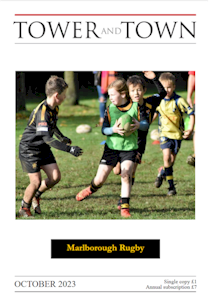

Tower and Town, October 2023 (view the full edition) (view the full edition)Nature NotesThe weather and birds: In the sonnet accompanying Vivaldi's Spring from the Four Seasons the birds "welcome it in joyful song", a cue for three warbling violins to strike up. "The sky darkens, and there is thunder and lightning" (rushing scales and trembling unisons) and then "the little birds return and all sing anew." (renewed warblings!) It may be a truism but it is always a delight, after a period of prolonged rain, to see the sun shining and birds emerging from shelter, singing away and hurrying about their business, as if making up for lost time. Birds are weather dependent in all manner of ways, just as we humans are. Our common summer immigrants, due to their size and weight, prefer to fly with a tailwind to make their journey easier. After a period of inhibiting cold northerlies in late March, a change to warm, light southerlies will accelerate the arrival of iconic species: Chiff Chaff and Blackcap, Swallow and House Martin, Redstart and Cuckoo. It isn't always plain sailing in the breeding season: a flood can wash out a Kingfisher's nest hole on a river bank or a Plover's nest on the floor of a gravel pit. Early breeders such as Stone Curlews and Barn Owls are sometimes faced with unseasonal conditions in April: cold, saturated ground can ruin the Curlew's scrape and frozen earth prevents the Owls from hunting rodents and small mammals. Come summer and birds are increasingly faced with hot weather. The smaller species will cool off in a bird bath or a wet gutter, or open up their wings and spread their feathers. Birds can pant, opening their beaks and breathing heavily: air rushes in causing the moisture in their lungs, throat and mouths to evaporate, which absorbs heat and helps keep them cool. In the autumn birders keep an eye on weather forecasts, especially if they are sea-watchers. On the Land's End peninsular they will be huddled together by Pendeen Lighthouse when the wind is north westerly, then switch to Porthgwarra for a south westerly-their quarry passing auks, shearwaters, skuas and petrels. Even in Wiltshire storm-blown vagrants turn up in October and November. A Grey Phalarope spent a few days on the Crammer Pond in Devizes in 2005 and more recently a Kittiwake appeared there amongst the Black-headed Gulls. In winter wild birds can be tamed by the freezing cold. Fieldfares and Redwings will raid orchards for fallen apples and bird tables become important sources of food and unfrozen water.  Grey Phalarope in Winter Plumage Robin Nelson |